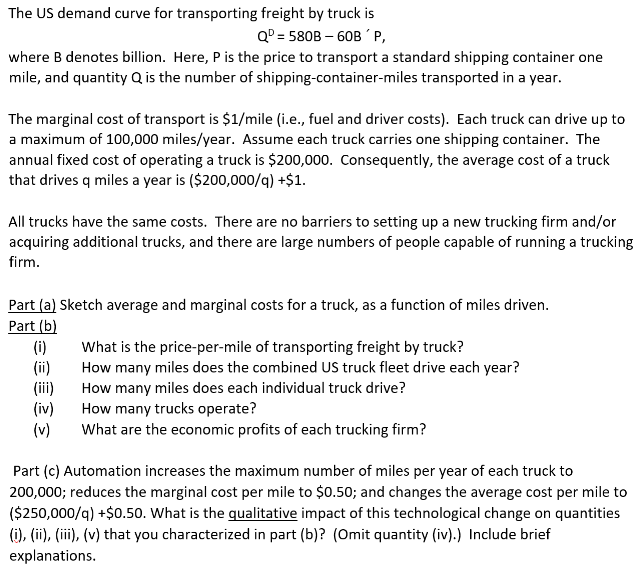The US demand curve for transporting freight by truck is Q° = 580B – 60B ´ P, where B denotes billion. Here, P is the price to transport a standard shipping container one mile, and quantity Q is the number of shipping-container-miles transported in a year. The marginal cost of transport is $1/mile (i.e., fuel and driver costs). Each truck can drive up to a maximum of 100,000 miles/year. Assume each truck carries one shipping container. The annual fixed cost of operating a truck is $200,000. Consequently, the average cost of a truck that drives q miles a year is ($200,000/q) +$1. All trucks have the same costs. There are no barriers to setting up a new trucking firm and/or acquiring additional trucks, and there are large numbers of people capable of running a trucking firm. Part (a) Sketch average and marginal costs for a truck, as a function of miles driven. Part (b) (i) (ii) What is the price-per-mile of transporting freight by truck? How many miles does the combined US truck fleet drive each year?
The US demand curve for transporting freight by truck is Q° = 580B – 60B ´ P, where B denotes billion. Here, P is the price to transport a standard shipping container one mile, and quantity Q is the number of shipping-container-miles transported in a year. The marginal cost of transport is $1/mile (i.e., fuel and driver costs). Each truck can drive up to a maximum of 100,000 miles/year. Assume each truck carries one shipping container. The annual fixed cost of operating a truck is $200,000. Consequently, the average cost of a truck that drives q miles a year is ($200,000/q) +$1. All trucks have the same costs. There are no barriers to setting up a new trucking firm and/or acquiring additional trucks, and there are large numbers of people capable of running a trucking firm. Part (a) Sketch average and marginal costs for a truck, as a function of miles driven. Part (b) (i) (ii) What is the price-per-mile of transporting freight by truck? How many miles does the combined US truck fleet drive each year?
Managerial Economics: Applications, Strategies and Tactics (MindTap Course List)
14th Edition
ISBN:9781305506381
Author:James R. McGuigan, R. Charles Moyer, Frederick H.deB. Harris
Publisher:James R. McGuigan, R. Charles Moyer, Frederick H.deB. Harris
Chapter2: Fundamental Economic Concepts
Section: Chapter Questions
Problem 2E
Related questions
Question

Transcribed Image Text:The US demand curve for transporting freight by truck is
а° - 580B - 60в "Р,
where B denotes billion. Here, P is the price to transport a standard shipping container one
mile, and quantity Q is the number of shipping-container-miles transported in a year.
The marginal cost of transport is $1/mile (i.e., fuel and driver costs). Each truck can drive up to
a maximum of 100,000 miles/year. Assume each truck carries one shipping container. The
annual fixed cost of operating a truck is $200,000. Consequently, the average cost of a truck
that drives q miles a year is ($200,000/q) +$1.
All trucks have the same costs. There are no barriers to setting up a new trucking firm and/or
acquiring additional trucks, and there are large numbers of people capable of running a trucking
firm.
Part (a) Sketch average and marginal costs for a truck, as a function of miles driven.
Part (b)
(i)
(ii)
(ii)
(iv)
(v)
What is the price-per-mile of transporting freight by truck?
How many miles does the combined US truck fleet drive each year?
How many miles does each individual truck drive?
How many trucks operate?
What are the economic profits of each trucking firm?
Part (c) Automation increases the maximum number of miles per year of each truck to
200,000; reduces the marginal cost per mile to $0.50; and changes the average cost per mile to
($250,000/g) +$0.50. What is the qualitative impact of this technological change on quantities
(i), (ii), (iii), (v) that you characterized in part (b)? (Omit quantity (iv).) Include brief
explanations.
Expert Solution
This question has been solved!
Explore an expertly crafted, step-by-step solution for a thorough understanding of key concepts.
This is a popular solution!
Trending now
This is a popular solution!
Step by step
Solved in 5 steps with 2 images

Knowledge Booster
Learn more about
Need a deep-dive on the concept behind this application? Look no further. Learn more about this topic, economics and related others by exploring similar questions and additional content below.Recommended textbooks for you

Managerial Economics: Applications, Strategies an…
Economics
ISBN:
9781305506381
Author:
James R. McGuigan, R. Charles Moyer, Frederick H.deB. Harris
Publisher:
Cengage Learning

Managerial Economics: Applications, Strategies an…
Economics
ISBN:
9781305506381
Author:
James R. McGuigan, R. Charles Moyer, Frederick H.deB. Harris
Publisher:
Cengage Learning